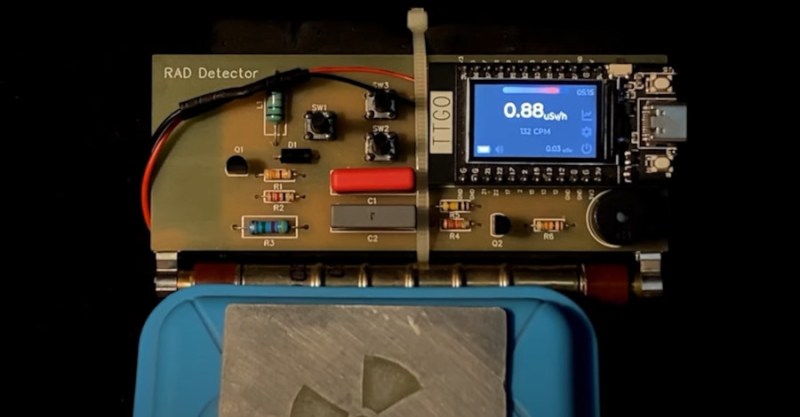There’s no shortage of Geiger counter projects based on the old Soviet SBM-20 tube, it’s a classic circuit that’s easy enough even for a beginner to implement — so long as they don’t get bitten by the 400 volts going into the tube, that is. Toss in a microcontroller, and not only does that circuit get even easier to put together and tweak, but now the features and capabilities of the device are only limited by how much code you want to write.
 Luckily for us, [Omar Khorshid] isn’t afraid of wrangling some 0s and 1s, and the result is the OpenRad project. In terms of hardware, it’s the standard SBM-20 circuit augmented with a LILYGO ESP32 development board that includes a TFT display. But where this one really shines is the firmware.
Luckily for us, [Omar Khorshid] isn’t afraid of wrangling some 0s and 1s, and the result is the OpenRad project. In terms of hardware, it’s the standard SBM-20 circuit augmented with a LILYGO ESP32 development board that includes a TFT display. But where this one really shines is the firmware.
With the addition of a few hardware buttons, [Omar] was able to put together a very capable interface that runs locally on the device itself. In addition, the ESP32 serves up a web page that provides some impressive real-time data visualizations. It will even publish its data via MQTT if you want to plug it into your home automation system or other platform.
Between the project’s Hackaday.io page and GitHub repository, [Omar] has done a fantastic job of documenting the project so that others can recreate it. That includes providing the schematics, KiCad files, and Gerbers necessary to not only get the boards produced and assembled, but modified should you want to adapt the base OpenRad design.
This project reminds us of the uRADMonitor, which [Radu Motisan] first introduced in 2014 to bring radiation measuring to the masses. This sort of hardware has become far more accessible over the last decade, bringing the dream of a globally distributed citizen-operated network of radiation and environmental monitors much closer to reality.















Two points:
– No regulation of the tube supply voltage. Meaning, the voltage can be inside the window the tube requires, or not. You’ll never know. Also, as the boost converter is always running, it’ll waste a lot of energy.
– A simple boost converter will most likely not be enough to keep the tube voltage high enough in case of high radiation (= a lot of counts). You’ll likely loose counts and therefore underestimate the radiation.
My suggestion: Use a transformer and add a voltage feedback, so the ESP32 can adapt the duty cycle.
Without being a nudge for the many geiger counter projects out there, point 1 above is critical. You *have* to be in the plateau of the geiger tube for any kind of accuracy, just hearing the system give clicks isn’t sufficient, and the plateaus vary between individual devices.
There’s a tuning procedure to find the plateau. It’s not hard, if you’re going to have a project then you might as well go the extra 5% to make an accurate one. You can’t just give the voltage value from the spec and expect it to work well.
Alternately, you can get a calibrated source or compare your device to a calibrated counter. That’s sometimes useful but a lot of trouble if you’re only going to make one.
I was helping
Great Project!
I have no experience in using geiger müller tubes, however the about 30mil clearance, from the high voltage circuit to ground, do seem a bit tight?
Using IPC-2221B spacing, the clearance should be around 100mil, right?
Please correct me if I am wrong.
Great project!
I have no experience using geiger tubes, however 30mil clearance from the high voltage circuit to ground do seem a bit tight?
Using IPC-2221B spacing the clearance should be about 100mil, right?
Please do correct me if I am wrong!